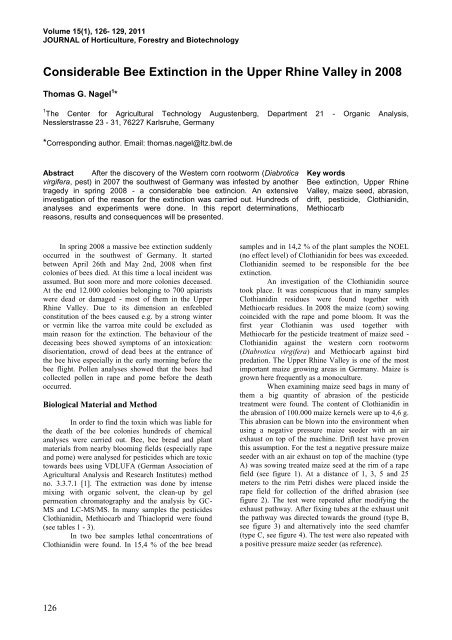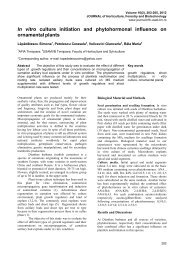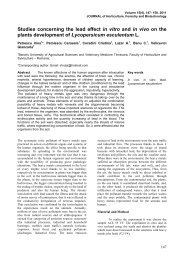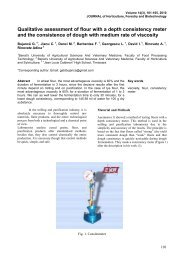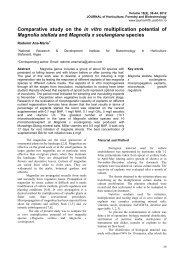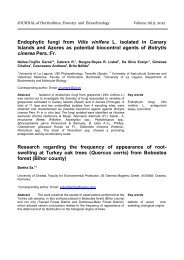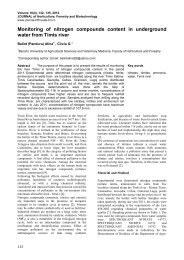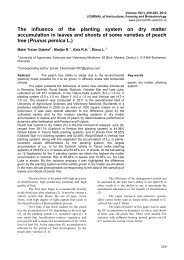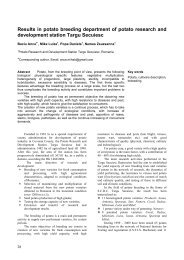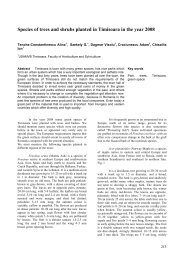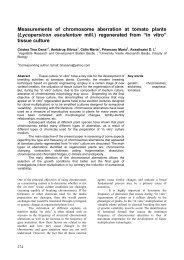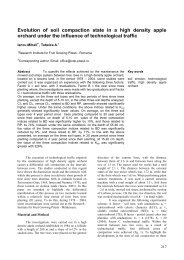Tremendous Bee Extinction at the Upper Rhine Valley in 2008
Tremendous Bee Extinction at the Upper Rhine Valley in 2008
Tremendous Bee Extinction at the Upper Rhine Valley in 2008
- No tags were found...
Create successful ePaper yourself
Turn your PDF publications into a flip-book with our unique Google optimized e-Paper software.
Volume 15(1), 126- 129, 2011JOURNAL of Horticulture, Forestry and BiotechnologyConsiderable <strong>Bee</strong> <strong>Ext<strong>in</strong>ction</strong> <strong>in</strong> <strong>the</strong> <strong>Upper</strong> <strong>Rh<strong>in</strong>e</strong> <strong>Valley</strong> <strong>in</strong> <strong>2008</strong>Thomas G. Nagel 1 *1 The Center for Agricultural Technology Augustenberg, Department 21 - Organic Analysis,Nesslerstrasse 23 - 31, 76227 Karlsruhe, Germany*Correspond<strong>in</strong>g author. Email: thomas.nagel@ltz.bwl.deAbstract After <strong>the</strong> discovery of <strong>the</strong> Western corn rootworm (Diabroticavirgifera, pest) <strong>in</strong> 2007 <strong>the</strong> southwest of Germany was <strong>in</strong>fested by ano<strong>the</strong>rtragedy <strong>in</strong> spr<strong>in</strong>g <strong>2008</strong> - a considerable bee ext<strong>in</strong>cion. An extensive<strong>in</strong>vestig<strong>at</strong>ion of <strong>the</strong> reason for <strong>the</strong> ext<strong>in</strong>ction was carried out. Hundreds ofanalyses and experiments were done. In this report determ<strong>in</strong><strong>at</strong>ions,reasons, results and consequences will be presented.Key words<strong>Bee</strong> ext<strong>in</strong>ction, <strong>Upper</strong> <strong>Rh<strong>in</strong>e</strong><strong>Valley</strong>, maize seed, abrasion,drift, pesticide, Clothianid<strong>in</strong>,MethiocarbIn spr<strong>in</strong>g <strong>2008</strong> a massive bee ext<strong>in</strong>ction suddenlyoccurred <strong>in</strong> <strong>the</strong> southwest of Germany. It startedbetween April 26th and May 2nd, <strong>2008</strong> when firstcolonies of bees died. At this time a local <strong>in</strong>cident wasassumed. But soon more and more colonies deceased.At <strong>the</strong> end 12.000 colonies belong<strong>in</strong>g to 700 apiaristswere dead or damaged - most of <strong>the</strong>m <strong>in</strong> <strong>the</strong> <strong>Upper</strong><strong>Rh<strong>in</strong>e</strong> <strong>Valley</strong>. Due to its dimension an enfeebledconstitution of <strong>the</strong> bees caused e.g. by a strong w<strong>in</strong>teror verm<strong>in</strong> like <strong>the</strong> varroa mite could be excluded asma<strong>in</strong> reason for <strong>the</strong> ext<strong>in</strong>ction. The behaviour of <strong>the</strong>deceas<strong>in</strong>g bees showed symptoms of an <strong>in</strong>toxic<strong>at</strong>ion:disorient<strong>at</strong>ion, crowd of dead bees <strong>at</strong> <strong>the</strong> entrance of<strong>the</strong> bee hive especially <strong>in</strong> <strong>the</strong> early morn<strong>in</strong>g before <strong>the</strong>bee flight. Pollen analyses showed th<strong>at</strong> <strong>the</strong> bees hadcollected pollen <strong>in</strong> rape and pome before <strong>the</strong> de<strong>at</strong>hoccurred.Biological M<strong>at</strong>erial and MethodIn order to f<strong>in</strong>d <strong>the</strong> tox<strong>in</strong> which was liable for<strong>the</strong> de<strong>at</strong>h of <strong>the</strong> bee colonies hundreds of chemicalanalyses were carried out. <strong>Bee</strong>, bee bread and plantm<strong>at</strong>erials from nearby bloom<strong>in</strong>g fields (especially rapeand pome) were analysed for pesticides which are toxictowards bees us<strong>in</strong>g VDLUFA (German Associ<strong>at</strong>ion ofAgricultural Analysis and Research Institutes) methodno. 3.3.7.1 [1]. The extraction was done by <strong>in</strong>tensemix<strong>in</strong>g with organic solvent, <strong>the</strong> clean-up by gelperme<strong>at</strong>ion chrom<strong>at</strong>ography and <strong>the</strong> analysis by GC-MS and LC-MS/MS. In many samples <strong>the</strong> pesticidesClothianid<strong>in</strong>, Methiocarb and Thiacloprid were found(see tables 1 - 3).In two bee samples lethal concentr<strong>at</strong>ions ofClothianid<strong>in</strong> were found. In 15,4 % of <strong>the</strong> bee breadsamples and <strong>in</strong> 14,2 % of <strong>the</strong> plant samples <strong>the</strong> NOEL(no effect level) of Clothianid<strong>in</strong> for bees was exceeded.Clothianid<strong>in</strong> seemed to be responsible for <strong>the</strong> beeext<strong>in</strong>ction.An <strong>in</strong>vestig<strong>at</strong>ion of <strong>the</strong> Clothianid<strong>in</strong> sourcetook place. It was conspicuous th<strong>at</strong> <strong>in</strong> many samplesClothianid<strong>in</strong> residues were found toge<strong>the</strong>r withMethiocarb residues. In <strong>2008</strong> <strong>the</strong> maize (corn) sow<strong>in</strong>gco<strong>in</strong>cided with <strong>the</strong> rape and pome bloom. It was <strong>the</strong>first year Clothian<strong>in</strong> was used toge<strong>the</strong>r withMethiocarb for <strong>the</strong> pesticide tre<strong>at</strong>ment of maize seed -Clothianid<strong>in</strong> aga<strong>in</strong>st <strong>the</strong> western corn rootworm(Diabrotica virgifera) and Methiocarb aga<strong>in</strong>st birdpred<strong>at</strong>ion. The <strong>Upper</strong> <strong>Rh<strong>in</strong>e</strong> <strong>Valley</strong> is one of <strong>the</strong> mostimportant maize grow<strong>in</strong>g areas <strong>in</strong> Germany. Maize isgrown here frequently as a monoculture.When exam<strong>in</strong><strong>in</strong>g maize seed bags <strong>in</strong> many of<strong>the</strong>m a big quantity of abrasion of <strong>the</strong> pesticidetre<strong>at</strong>ment were found. The content of Clothianid<strong>in</strong> <strong>in</strong><strong>the</strong> abrasion of 100.000 maize kernels were up to 4,6 g.This abrasion can be blown <strong>in</strong>to <strong>the</strong> environment whenus<strong>in</strong>g a neg<strong>at</strong>ive pressure maize seeder with an airexhaust on top of <strong>the</strong> mach<strong>in</strong>e. Drift test have proventhis assumption. For <strong>the</strong> test a neg<strong>at</strong>ive pressure maizeseeder with an air exhaust on top of <strong>the</strong> mach<strong>in</strong>e (typeA) was sow<strong>in</strong>g tre<strong>at</strong>ed maize seed <strong>at</strong> <strong>the</strong> rim of a rapefield (see figure 1). At a distance of 1, 3, 5 and 25meters to <strong>the</strong> rim Petri dishes were placed <strong>in</strong>side <strong>the</strong>rape field for collection of <strong>the</strong> drifted abrasion (seefigure 2). The test were repe<strong>at</strong>ed after modify<strong>in</strong>g <strong>the</strong>exhaust p<strong>at</strong>hway. After fix<strong>in</strong>g tubes <strong>at</strong> <strong>the</strong> exhaust unit<strong>the</strong> p<strong>at</strong>hway was directed towards <strong>the</strong> ground (type B,see figure 3) and altern<strong>at</strong>ively <strong>in</strong>to <strong>the</strong> seed chamfer(type C, see figure 4). The test were also repe<strong>at</strong>ed witha positive pressure maize seeder (as reference).126
Table 1<strong>Bee</strong> samplesContent Clothianid<strong>in</strong> Methiocarb Thiachlopridµg/kg ng/bee Quantity % Quantity % Quantity %< 1 < 0,1 21 16,5 85 66,9 54 81,81 – 5 0,1 - 0,5 18 14,2 36 28,3 10 15,25 – 10 0,5 - 1,0 47 37 5 3,9 2 310 – 15 1,0 - 1,5 26 20,5 - - - -15 – 20 1,5 - 2,0 8 6,3 1 0,8 - -20 – 40 2,0 - 4,0 4 3,2 - - - -> 40 > 4,0 2 1,6 - - - -<strong>Bee</strong> bread samplesContent Clothianid<strong>in</strong> Methiocarb Thiachlopridµg/kg Quantity % Quantity % Quantity %< 1 77 65,8 53 45,3 29 38,11 - 5 7 6 22 18,8 8 10,55 - 10 6 5,1 12 10,3 14 18,410 - 15 8 6,8 12 10,3 7 9,215 - 20 1 0,9 6 5,1 4 5,320 - 50 13 11,1 8 6,8 7 9,250 - 100 5 4,3 4 3,4 4 5,3> 100 - - - - 3 4Plant samplesContent Clothianid<strong>in</strong> Methiocarb Thiachlopridµg/kg Quantity % Quantity % Quantity %< 1 77 65,8 53 45,3 29 38,11 - 5 7 6 22 18,8 8 10,55 - 10 6 5,1 12 10,3 14 18,410 - 15 8 6,8 12 10,3 7 9,215 - 20 1 0,9 6 5,1 4 5,320 - 50 13 11,1 8 6,8 7 9,250 - 100 5 4,3 4 3,4 4 5,3> 100 - - - - 3 4Table 2Table 3Figure 1 Neg<strong>at</strong>ive pressure maize seederFigure 2 Petri dishes <strong>in</strong>side a maize field127
Clothianid<strong>in</strong> content [µg/kg]Figure 3 Exhaust after modific<strong>at</strong>ion type BFigure 4 Exhaust after modific<strong>at</strong>ion type C14012010080Type AType BType CReference60402001 3 5 25Distance [m]Figure 5 The Clothianid<strong>in</strong> content of rape plants <strong>in</strong> different distances to <strong>the</strong> rim of <strong>the</strong> fieldFigure 5 shows <strong>the</strong> results of <strong>the</strong> test. Amodific<strong>at</strong>ion of <strong>the</strong> exhaust p<strong>at</strong>hway <strong>in</strong>to <strong>the</strong> seedchamfer (type C) reduces <strong>the</strong> drift of <strong>the</strong> abrasion to am<strong>in</strong>imum. The drift is comparable <strong>in</strong> this case to th<strong>at</strong>of a positive pressure seeder.Results and DiscussionsThe considerable bee ext<strong>in</strong>ction <strong>in</strong> <strong>the</strong> <strong>Upper</strong><strong>Rh<strong>in</strong>e</strong> <strong>Valley</strong> <strong>in</strong> <strong>the</strong> year <strong>2008</strong> is <strong>the</strong> result of aco<strong>in</strong>cidence of unfortun<strong>at</strong>e events:‣ Applic<strong>at</strong>ion of Clothianid<strong>in</strong> <strong>in</strong> maize seedtre<strong>at</strong>ment aga<strong>in</strong>st <strong>the</strong> western corn rootworm(Diabrotica virgifera)128
‣ Inadequ<strong>at</strong>e quality of seed tre<strong>at</strong>ment (lowdegree of adhesion) which causes abrasion‣ High drift when us<strong>in</strong>g conventional neg<strong>at</strong>ivepressure maize seeder‣ Huge maize grow<strong>in</strong>g area (mostly monoculture)‣ Clim<strong>at</strong>ic conditions (maize sow<strong>in</strong>g co<strong>in</strong>cidedwith <strong>the</strong> rape and pome bloom)‣ Enfeebled bee colonies (varroa mite)ConclusionsAs a consequence of <strong>the</strong> bee ext<strong>in</strong>ction seedtre<strong>at</strong>ment with Clothianid<strong>in</strong> and o<strong>the</strong>r pestides of <strong>the</strong>chemical class of neonicot<strong>in</strong>oids (Imidacloprid,Thiamethoxam) became forbidden <strong>in</strong> Germany. Amaximum level of abrasion for maize seed tre<strong>at</strong>ed withMethiocarb was issued. The seed of maize kerneltre<strong>at</strong>ed with Methiocarb with neg<strong>at</strong>ive pressure maizeseeder is only permitted if <strong>the</strong> seeder is modified toreduce drift by 90 %. The compliance of <strong>the</strong>regul<strong>at</strong>ions will be observed by <strong>the</strong> authorities.References1.VDLUFA, Methods book VII, 3rd Edition, VDLUFAVerlag, Darmstadt (Germany), <strong>2008</strong>.129


